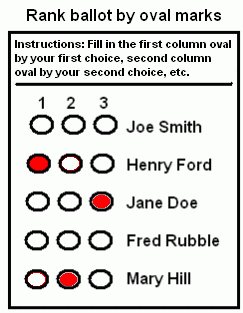
Plurality voting refers to electoral systems in which the candidates in an electoral district who poll more than any other are elected.

The single transferable vote (STV) or proportional-ranked choice voting (P-RCV) is a multi-winner electoral system in which each voter casts a single vote in the form of a ranked ballot. Voters have the option to rank candidates, and their vote may be transferred according to alternative preferences if their preferred candidate is eliminated or elected with surplus votes, so that their vote is used to elect someone they prefer over others in the running. STV aims to approach proportional representation based on votes cast in the district where it is used, so that each vote is worth about the same as another.

A Condorcet method is an election method that elects the candidate who wins a majority of the vote in every head-to-head election against each of the other candidates, whenever there is such a candidate. A candidate with this property, the pairwise champion or beats-all winner, is formally called the Condorcet winner or Pairwise Majority Rule Winner (PMRW). The head-to-head elections need not be done separately; a voter's choice within any given pair can be determined from the ranking.

Voting refers to the process of choosing officials or policies by casting a ballot, a document used by people to formally express their preferences. Republics and representative democracies are governments where the population chooses representatives by voting.

The Copeland or Llull method is a ranked-choice voting system based on counting each candidate's pairwise wins and losses.
The Gibbard–Satterthwaite theorem is a theorem in social choice theory. It was first conjectured by the philosopher Michael Dummett and the mathematician Robin Farquharson in 1961 and then proved independently by the philosopher Allan Gibbard in 1973 and economist Mark Satterthwaite in 1975. It deals with deterministic ordinal electoral systems that choose a single winner, and shows that for every voting rule of this form, at least one of the following three things must hold:
- The rule is dictatorial, i.e. there exists a distinguished voter who can choose the winner; or
- The rule limits the possible outcomes to two alternatives only; or
- The rule is not straightforward, i.e. there is no single always-best strategy.
Strategic nomination refers to the entry of a candidate into an election with the intention of changing the ranking of other candidates. The name is an echo of ‘tactical voting’ and is intended to imply that it is the candidates rather than the voters who are seeking to manipulate the result in a manner unfaithful to voters’ true preferences.

Bucklin voting is a class of voting methods that can be used for single-member and multi-member districts. As in highest median rules like the majority judgment, the Bucklin winner will be one of the candidates with the highest median ranking or rating. It is named after its original promoter, the Georgist politician James W. Bucklin of Grand Junction, Colorado, and is also known as the Grand Junction system.

A Condorcet winner is a candidate who would receive the support of more than half of the electorate in a one-on-one race against any one of their opponents. Voting systems where a majority winner will always win are said to satisfy the Condorcet winner criterion. The Condorcet winner criterion extends the principle of majority rule to elections with multiple candidates.
The single transferable vote (STV) is a proportional representation system and ranked voting rule that elects multiple winners. Under STV, an elector's vote is initially allocated to their first-ranked candidate. Candidates are elected (winners) if their vote tally exceeds the electoral quota. Any surplus votes (those exceeding quota) are transferred from winners to the remaining candidates (hopefuls) according to the surplus ballots' next usable back-up preference.

The Borda count electoral system can be combined with an instant-runoff procedure to create hybrid election methods that are called Nanson method and Baldwin method. Both methods are designed to satisfy the Condorcet criterion, and allow for incomplete ballots and equal rankings.

In social choice theory, the best-is-worst paradox occurs when a voting rule declares the same candidate to be both the best and worst possible winner. The worst candidate can be identified by reversing each voter's ballot, then applying the voting rule to the reversed ballots find a new "anti-winner".

In social choice theory, the independence of (irrelevant) clones criterion says that adding a clone, i.e. a new candidate very similar to an already-existing candidate, should not spoil the results. It can be considered a weak form of the independence of irrelevant alternatives (IIA) criterion that nevertheless is failed by a number of voting rules. A method that passes the criterion is said to be clone independent.
There are a number of complications and issues surrounding the application and use of single transferable vote proportional representation that form the basis of discussions between its advocates and detractors.

In election science, a voting method satisfies the summability criterion if it is possible to tally election results locally by precinct, then calculate the results by adding up all the votes. More formally, the compilation or summation complexity of a voting system measures the difficulty of vote counting for individual precincts, and is equal to the smallest number of bits needed to summarize all the votes. A voting method is called summable if the number of bits grows as a polynomial function of the number of candidates.

The Borda method or order of merit is a positional voting rule that gives each candidate a number of points equal to the number of candidates ranked below them: the lowest-ranked candidate gets 0 points, the second-lowest gets 1 point, and so on. The candidate with the most points wins.

Instant-runoff voting is a single-winner, multi-round elimination rule that uses ranked voting to simulate a series of runoff elections. In each round, the candidate with the fewest first-preferences is eliminated. This continues until only one candidate is left. Instant runoff falls under the plurality-with-elimination family of voting methods, and is thus closely related to rules like the two-round runoff system.

An electoral or voting system is a set of rules used to determine the results of an election. Electoral systems are used in politics to elect governments, while non-political elections may take place in business, non-profit organisations and informal organisations. These rules govern all aspects of the voting process: when elections occur, who is allowed to vote, who can stand as a candidate, how ballots are marked and cast, how the ballots are counted, how votes translate into the election outcome, limits on campaign spending, and other factors that can affect the result. Political electoral systems are defined by constitutions and electoral laws, are typically conducted by election commissions, and can use multiple types of elections for different offices.

Ranked voting is any voting system that uses voters' rankings of candidates to choose a single winner or multiple winners. More formally, a ranked system is one that depends only on which of two candidates is preferred by a voter, and as such does not incorporate any information about intensity of preferences. Ranked voting systems vary dramatically in how preferences are tabulated and counted, which gives them very different properties. In instant-runoff voting (IRV) and the single transferable vote system (STV), lower preferences are used as contingencies and are only applied when all higher-ranked preferences on a ballot have been eliminated or when the vote has been cast for a candidate who has been elected and surplus votes need to be transferred.
There are a number of different criteria which can be used for voting systems in an election, including the following









